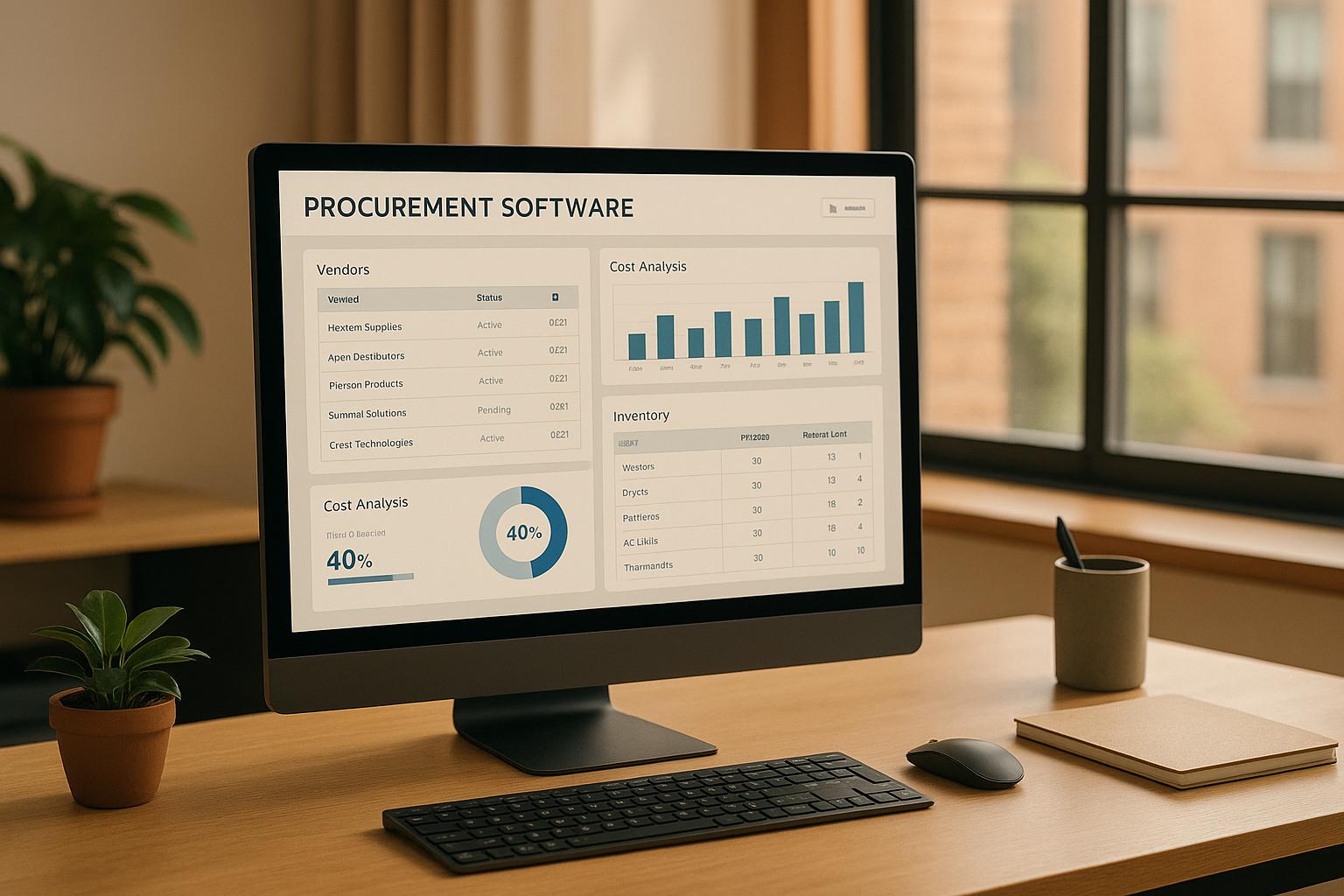Choosing between all-in-one leasing platforms and point solutions boils down to your property management needs. All-in-one platforms consolidate tools like tenant management, maintenance scheduling, and payments into one system, simplifying workflows. Point solutions, on the other hand, focus on specific tasks, offering deeper functionality for niche needs. Here's a quick breakdown:
All-in-One Platforms:
- Pros: Centralized data, single vendor relationship, easier staff training, and fewer integration headaches.
- Cons: Limited customization, potential for unused features, and challenges with system-wide updates.
Point Solutions:
- Pros: Specialized functionality, lower initial costs, and flexibility to choose tools that fit your needs.
- Cons: Integration issues, managing multiple vendors, and potential data silos.
Key Considerations:
- Portfolio size: Larger portfolios often benefit from all-in-one systems, while smaller ones may prefer point solutions.
- Complexity: All-in-one platforms handle diverse needs better, whereas point solutions excel in specific areas.
- Costs: All-in-one systems may cost more upfront but reduce long-term expenses. Point solutions can add up over time with multiple subscriptions and integrations.
Your decision should align with your operational goals, budget, and growth plans.
6 of the Best Apartment Management Software Solutions
All-in-One Leasing Platforms: Benefits and Drawbacks
Let’s take a closer look at the pros and cons of all-in-one leasing platforms. These systems combine key tools - like tenant screening, lease management, maintenance tracking, and financial reporting - into one centralized solution. While this streamlined approach offers clear operational perks, it’s not without its challenges. Multifamily operators need to weigh these carefully before committing.
Benefits of All-in-One Platforms
One of the standout advantages is centralized data management. With all tenant information, lease agreements, payment records, and maintenance requests housed in a single system, manual errors are minimized, and decision-making becomes more efficient. This approach eliminates the need to juggle multiple tools, reducing the risk of lost or siloed information.
A unified user experience makes day-to-day tasks easier. Staff members can handle everything - whether it’s processing rental applications, scheduling repairs, or generating reports - through one interface. There’s no need to navigate multiple systems or remember different logins, which simplifies workflows and saves time.
Another benefit is streamlined vendor management. Operators deal with just one support team and one billing relationship, cutting down on administrative headaches. Plus, easier staff training is a natural result. New hires only need to learn one system, which shortens onboarding time and helps them become productive faster. This also benefits residents, as staff can provide better support for online portals or applications.
While these advantages enhance efficiency, they come with some notable downsides.
Drawbacks of All-in-One Platforms
One key downside is limited feature depth. Compared to specialized tools, all-in-one platforms may lack the depth and customization options needed to handle unique workflows. These systems often aim to fit a broad range of users, which can lead to challenges if your processes don’t align with their pre-set features. Even when customization is available, it’s usually more restricted than what dedicated solutions offer [3].
Another issue is paying for features you don’t need. Many platforms bundle tools together, which might leave you paying for modules that go unused. At the same time, you may still find yourself missing specific functionalities that could better serve your operations [1][3].
Integration challenges can also arise. Even within the same vendor’s ecosystem, data gaps may occur, and system-wide updates can disrupt operations. Unlike standalone tools, where you can schedule upgrades individually, these platforms often require simultaneous updates across the board, which can lead to downtime if issues occur [1][3].
Finally, support limitations can be frustrating. Support teams for these platforms often have broad but shallow expertise, which means they may struggle to resolve complex issues tied to specific modules [3].
All-in-One Platforms Comparison Table
| Advantages | Disadvantages |
|---|---|
| Centralized data management prevents silos | Limited feature depth and customization options |
| Unified interface simplifies daily tasks | May include unused features, adding unnecessary costs |
| Single vendor for contracts and support | Integration between modules may not be seamless |
| Easier training and onboarding for staff | Support teams may lack in-depth knowledge of specific tools |
| Streamlined billing and administration | System-wide updates can disrupt operations |
The choice to adopt an all-in-one platform boils down to your specific needs. If your operations are relatively standard and you value simplicity, these platforms can enhance efficiency. However, if your property has unique processes or requires top-tier functionality in certain areas, the trade-offs might outweigh the benefits.
Point Solutions: Benefits and Drawbacks
Building on our earlier discussion of all-in-one platforms, point solutions take a different approach by focusing on depth rather than breadth. These tools are designed to handle specific tasks, giving operators the flexibility to choose specialized tools for each function. While this targeted approach has clear advantages, it also introduces challenges that operators need to navigate.
Benefits of Point Solutions
One of the biggest strengths of point solutions is their ability to deliver highly specialized functionality. These tools are built with a singular purpose in mind, which means they can offer features tailored to specific needs. For instance, RemoteLock allows managers to efficiently assign and revoke digital credentials, simplifying access control tasks [2].
Another advantage is the speed of implementation. Since these tools have fewer features and dependencies, they are typically quicker to set up and easier for staff to learn [6].
Cost flexibility is another appealing aspect. With point solutions, you only pay for the features you need, and you can adjust your usage as your business evolves [11]. Additionally, the specialized nature of these tools encourages rapid development. Dedicated teams can focus on refining a narrow set of features, allowing them to respond quickly to emerging needs or local challenges. As Kerry W. Kirby and Jimmy Lancaster from the Multifamily Tech Gurus Podcast Series explain:
"The multifamily housing industry is at a critical juncture where technology integration is not just an advantage but a necessity for staying competitive. As the demand for more efficient operations and superior resident experiences grows, property managers and operators will unstack their one-size-fits-all software solutions and turn to highly specialized point solutions" [5].
The impact of these tools can be significant. For example, smart HVAC systems that adjust based on real-time occupancy data have been shown to improve operating efficiency by 20%, reduce operating costs by 18%, and cut energy costs by 19% [4].
Drawbacks of Point Solutions
Despite their strengths, point solutions come with their own set of challenges. Integration is a major hurdle - 89% of companies report issues with data and system compatibility, which can lead to inefficiencies and higher operational costs [7]. Managing multiple vendors adds to the complexity. Instead of a single point of contact for support or billing, operators must juggle relationships with several providers, and 72% of businesses cite software license management as a significant challenge [8].
Another downside is the learning curve. Different tools often come with varying interfaces, which means staff need extra training and must juggle multiple logins. Data silos are another issue, as information often gets trapped within individual systems, requiring manual transfers and limiting the ability to gain a comprehensive view across platforms [9].
Scalability can also be a limitation. As one industry expert points out, point solutions "are inherently difficult to scale because they are made for specific use-cases and can't quickly adopt new features to solve different problems" [6].
Point Solutions Comparison Table
| Advantages | Disadvantages |
|---|---|
| Focused, specialized functionality | Complex integration and data silos |
| Faster setup and easier learning for specific tasks | Managing multiple vendors and licenses |
| Pay only for the features you need | Inconsistent user experiences across tools |
| Quick adaptation to specific needs | Increased training requirements for staff |
| Flexibility to scale individual tools | Limited scalability for broader needs |
Ultimately, deciding whether to adopt point solutions depends on your organization’s specific operational challenges and whether you have the technical expertise to handle the integration and coordination involved. By weighing these benefits and drawbacks, multifamily operators can better determine if point solutions align with their goals.
sbb-itb-58157f8
What Multifamily Operators Should Consider
The differences between technology solutions can directly influence how efficiently your operations run, how adaptable your systems are, and even your overall costs. Choosing the right approach depends on factors like your business model, portfolio size, and operational goals. This decision will shape both your daily processes and your long-term growth, so it's worth taking the time to carefully evaluate your options.
Integration and Data Flow
How well your systems communicate with each other can have a huge impact on your operations. All-in-one platforms are designed to integrate seamlessly, allowing data to flow automatically between different modules. For instance, if a prospective tenant submits an application, the system can initiate background checks, update availability calendars, and generate lease documents - all without manual effort.
On the other hand, point solutions often require custom interfaces and ongoing maintenance to ensure tools work together. This setup can lead to data silos, which disrupt workflows and reduce efficiency. It's worth noting that 73% of IT leaders report saving 25% of their time on tasks thanks to automation[12], a benefit that integrated systems naturally provide. This smooth flow of data becomes even more critical as you plan for growth and need greater operational flexibility.
Flexibility and Scalability
Scalability is closely tied to how well your system handles integrated data flows. As your portfolio grows or market conditions shift, your technology needs will evolve. All-in-one platforms are built to scale, making it easier to add new properties, expand into different markets, or adjust workflows without overhauling your entire system.
Point solutions, by contrast, allow you to swap out individual tools as needs change. However, this flexibility often comes at a cost: businesses may need to adapt their processes to fit each tool, which can limit overall adaptability[14]. Meanwhile, Gartner predicts a 30.2% growth in Citizen Automation and Development Platforms in 2023[13], reflecting a strong demand for systems that can adjust to changing business requirements.
Ultimately, the choice between point solutions and all-in-one platforms depends on factors like your portfolio size, operational complexity, and long-term goals.
Pricing and Vendor Lock-In
The financial impact of your technology choice goes beyond just subscription costs. All-in-one platforms typically come with higher upfront costs, but their bundled pricing and reduced integration expenses may offer better value over time by avoiding redundant features and support fees.
Point solutions often have lower individual costs, but managing multiple subscriptions and integration expenses can drive up total costs. In fact, 90% of companies overpay for their SaaS products by 20%-30%[11], often due to juggling multiple subscriptions and paying for custom integrations.
Vendor lock-in is another key consideration. All-in-one platforms can create high switching costs, as migrating data and retraining staff is both time-consuming and expensive. While point solutions offer more flexibility to replace individual components, managing multiple vendor relationships can complicate operations. Interestingly, 84% of respondents prefer buying a single comprehensive tool over multiple solutions[15], showing that many operators value simplicity even if it means accepting some level of vendor lock-in.
| Cost Factor | All-in-One Platforms | Point Solutions |
|---|---|---|
| Initial Investment | Higher upfront costs | Lower individual costs |
| Long-term Expenses | Lower due to bundled pricing | Higher due to multiple subscriptions |
| Integration Costs | Minimal | Significant custom development |
| Vendor Management | Single relationship | Multiple contracts and renewals |
| Switching Costs | Very high | Moderate for individual tools |
Impact on Operations
Your choice of technology will directly influence your team’s efficiency and the experience you provide to residents. All-in-one platforms often boost staff productivity by reducing the need to juggle multiple systems, streamlining training, and providing a consistent user interface. Leasing teams, for example, can handle everything from inquiries to signed leases within one system.
Point solutions, while offering specialized tools for tasks like rent optimization or maintenance management, can lead to operational challenges. Managing several disconnected systems may increase overhead and create inefficiencies. Additionally, all-in-one platforms often deliver a more cohesive resident experience, with unified portals and communication tools, whereas point solutions can result in fragmented interactions.
When it comes to driving revenue and controlling costs - key factors for improving Net Operating Income - the right technology plays a crucial role. If your organization has dedicated IT resources and values customization, point solutions might work well. But if operational simplicity and a seamless experience are your priorities, an all-in-one platform is likely the better fit.
Choosing the Right Approach for Your Portfolio
Deciding between all-in-one platforms and point solutions depends on several factors: the size of your portfolio, the complexity of your operations, and your long-term objectives. For larger portfolios, centralized platforms often make sense due to their ability to streamline management and improve efficiency. On the other hand, smaller portfolios might lean toward specialized tools, avoiding unnecessary costs tied to unused features [1].
Operational complexity is another critical factor. If your team handles a mix of property types or operates across multiple markets, an all-in-one platform can simplify workflows and provide consolidated insights that are hard to achieve with a patchwork of tools [1]. However, if your operations are relatively simple and require specific functionalities, point solutions might deliver the precision you need.
Scalability is equally important. Point solutions often struggle to handle growth, whether it's an increase in data, users, or operational scope [9]. If expansion is on the horizon, consider a system that scales smoothly without requiring costly migrations.
Ease of use for your team is also a major consideration. A recent survey found that 39% of managers are dissatisfied with how their existing tech integrates with new tools [16]. Poor integration can lead to daily inefficiencies, so choosing a solution that fits seamlessly into your existing tech stack is vital [17].
Cost is another area that requires careful evaluation. While point solutions might seem cheaper upfront, adding more tools over time can drive up IT and administrative expenses [9]. All-in-one platforms, though potentially more expensive initially, often prove more economical in the long run due to their comprehensive features and reduced management overhead [9]. It's essential to calculate the total cost of ownership, factoring in integration and maintenance expenses [17].
Your current IT infrastructure also plays a role. If you have a strong IT team and prefer custom workflows, multiple point solutions could work. But if simplicity and minimal maintenance are priorities - especially with limited technical resources - an all-in-one platform might be the better choice.
Finally, think about your broader digital transformation goals. Many companies opt for comprehensive platforms to simplify operations and improve tenant satisfaction [14]. By aligning your technology choices with your growth strategy, you can ensure smoother integration and better long-term results.
The bottom line? Define your priorities clearly. Whether you go with an all-in-one platform or a collection of point solutions, the technology should align with your operational needs and position your portfolio for future success [10].
FAQs
What’s the best way to choose between an all-in-one leasing platform and point solutions for property management?
When deciding between an all-in-one leasing platform and point solutions, it all comes down to what you need for your property management strategy.
An all-in-one platform brings multiple tools together in a single system, making it easier to handle everything from one place. This approach works well for larger portfolios or teams that value a centralized, streamlined setup.
In contrast, point solutions focus on specific tasks, offering specialized features for areas like leasing or tenant communication. They’re a great option if you want more flexibility to build a custom tech stack tailored to your needs. However, using point solutions might mean extra work to ensure smooth integration with other software.
To choose the right option, think about factors like the size of your portfolio, your budget, and whether you prioritize ease of use and integration or prefer customization and specialized tools. Weighing these aspects carefully will guide you toward the best choice for your business.
What are the long-term cost differences between using an all-in-one platform and multiple point solutions?
When looking at long-term costs, all-in-one platforms might seem pricey upfront, but they often pay off over time. By bundling multiple features into one system, they cut down on the need for several subscriptions, streamline vendor management, and lower integration costs.
In contrast, point solutions usually come with a smaller initial price tag, but the long-term expenses can pile up. Juggling multiple tools often means spending more on integrations and coordinating with different vendors. Plus, switching between providers can get costly and complicated, which might make it harder to adapt as your needs evolve.
Choosing between the two comes down to what works for you - whether it’s sticking to a budget, planning for growth, or needing more flexibility to suit your operations.
What are the best ways to handle integration challenges when using multiple property management tools?
To address integration challenges effectively, begin by pinpointing your team's specific needs and objectives. Make sure your data is properly standardized and cleaned before transferring it between systems. Prioritize integrating tools that have a direct impact on daily workflows to reduce potential disruptions.
Provide role-specific training for your team, and assign tech-savvy individuals as system champions who can assist others. Develop accessible reference materials and set up regular feedback sessions to evaluate system performance. This hands-on strategy helps keep operations running smoothly and ensures your tools function harmoniously together.


